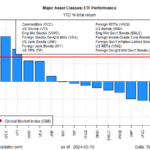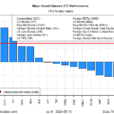
Equity bulls are at a crossroads amid the significant recalibration of expectations across the US rates landscape prompting a reevaluation of their outlook and strategy in navigating the evolving market dynamics.  Unsplash Last week, global equity markets received a much-needed boost from strong corporate earnings, providing relief amidst persistently high inflation readings. The uptick in the three-month annualized trend for the U.S. core PCE deflator to 4.4% in March will keep policymakers vigilant, dampening hopes for imminent rate relief.Despite the potential for a more alarming inflation report, the market response to the latest personal income and spending data remained relatively muted. While Friday’s release offered some positive indicators, it was within the context of existing conditions and came with certain caveats. The March PCE prices data suggested a resurgence of the idea that the recent uptick in inflation pressures could have been primarily driven by seasonal factors limited to January. It’s worth noting that the PCE data for February and March showed more favourable results than the CPI.Despite these seemingly positive developments, the situation remains precarious, with each data release keeping investors on edge. We’re still far from the slow, predictable disinflation scenario the Fed believes would warrant considering rate cuts.Previously, bullish sentiment was buoyed by the anticipation of multiple rate cuts, seen as a catalyst for sustained market growth. However, the narrative has shifted as market pricing reflects a more restrained approach ahead of the FOMC meeting with fewer projected rate reductions than the current dot plot for the year.In his final public remarks before the blackout period preceding the April 30-May 1 FOMC meeting, Fed Chair Jay Powell expressed concern about persistent inflation and resilient economic growth. Powell further emphasized that rate cuts would be on hold until the Fed gains greater confidence in inflation moving sustainably toward the 2 percent target. Hence, the market has virtually priced in a more hawkish Fed scenario; other than removing all cuts from the dot plot, it’s unlikely the Fed will hawkishly surprise the market. But in a worst-case scenario where the Fed pushes rate cuts out to 2025, this poses a critical question for equity bulls: Can they maintain confidence in the absence of easing measures this year?Still, the recent rates market reaction to inflationary pressures adds complexity to the equation. Despite persistent inflation concerns, equities have shown resilience, rallying even in the face of adverse economic indicators and higher bond yields, leaving both bears and most market professionals scratching their heads.Outside of stock market investors living vicariously on high-tech earning boosts, this recent hawkish turn of events doesn’t bode well for the economic landscape. The combination of rising interest rates, postponed Fed rate cuts, and relentless inflation trends threatens to dampen consumers’ willingness and ability to spend. Real consumer spending remained robust in March, but real disposable personal income growth has slowed markedly over the past year, while the personal savings rate has dropped to 3.2%, its lowest level since late 2022. The surge in nominal and real interest rates is likely to further weigh on consumer and business spending, including the housing market, in the coming quarters. The latest Fed Beige Book highlighted weak consumer discretionary spending and increasing price sensitivity among consumers.Moreover, more U.S. borrowers are struggling to keep up with credit card and motor vehicle payments as higher interest rates and inflation take their toll. Data from the New York Fed shows that the 30-day delinquency on car and credit card debt hit their highest levels since the 2007 recession in the fourth quarter. The slower-than-expected real consumer spending growth in the first quarter could be the start of a series of sluggish quarters ahead until inflation eases and the Fed adjusts its monetary stance.Assuming the FOMC maintains its easing bias, the timing of the easing trajectory likely matters less than the assurance that the Fed is prepared to implement rate cuts if economic growth stumbles. In the meantime, nominal growth continues to be robust, providing a foundation for strong earnings.Ultimately, despite grappling with persistent inflation in 2024, the Federal Reserve undoubtedly perceives the risks to its mandate as more balanced compared to a year ago. Consequently, the Fed would be particularly inclined to prioritize fostering economic growth, especially given its position in the hiking cycle, possibly near its terminal phase.In essence, this suggests that equities may not need to fret excessively about interest rates. The economy appears to be functioning well with rates at their current levels, and both households and corporations are managing adequately on aggregate. Therefore, despite hawkish signals and proximate rates market reactions, if the economy continues to thrive, the Fed would likely hesitate to implement rate hikes until circumstances necessitate otherwise.More By This Author:Earnings To The Rescue Amid Rekindled Hope For Inflation Seasonality
Unsplash Last week, global equity markets received a much-needed boost from strong corporate earnings, providing relief amidst persistently high inflation readings. The uptick in the three-month annualized trend for the U.S. core PCE deflator to 4.4% in March will keep policymakers vigilant, dampening hopes for imminent rate relief.Despite the potential for a more alarming inflation report, the market response to the latest personal income and spending data remained relatively muted. While Friday’s release offered some positive indicators, it was within the context of existing conditions and came with certain caveats. The March PCE prices data suggested a resurgence of the idea that the recent uptick in inflation pressures could have been primarily driven by seasonal factors limited to January. It’s worth noting that the PCE data for February and March showed more favourable results than the CPI.Despite these seemingly positive developments, the situation remains precarious, with each data release keeping investors on edge. We’re still far from the slow, predictable disinflation scenario the Fed believes would warrant considering rate cuts.Previously, bullish sentiment was buoyed by the anticipation of multiple rate cuts, seen as a catalyst for sustained market growth. However, the narrative has shifted as market pricing reflects a more restrained approach ahead of the FOMC meeting with fewer projected rate reductions than the current dot plot for the year.In his final public remarks before the blackout period preceding the April 30-May 1 FOMC meeting, Fed Chair Jay Powell expressed concern about persistent inflation and resilient economic growth. Powell further emphasized that rate cuts would be on hold until the Fed gains greater confidence in inflation moving sustainably toward the 2 percent target. Hence, the market has virtually priced in a more hawkish Fed scenario; other than removing all cuts from the dot plot, it’s unlikely the Fed will hawkishly surprise the market. But in a worst-case scenario where the Fed pushes rate cuts out to 2025, this poses a critical question for equity bulls: Can they maintain confidence in the absence of easing measures this year?Still, the recent rates market reaction to inflationary pressures adds complexity to the equation. Despite persistent inflation concerns, equities have shown resilience, rallying even in the face of adverse economic indicators and higher bond yields, leaving both bears and most market professionals scratching their heads.Outside of stock market investors living vicariously on high-tech earning boosts, this recent hawkish turn of events doesn’t bode well for the economic landscape. The combination of rising interest rates, postponed Fed rate cuts, and relentless inflation trends threatens to dampen consumers’ willingness and ability to spend. Real consumer spending remained robust in March, but real disposable personal income growth has slowed markedly over the past year, while the personal savings rate has dropped to 3.2%, its lowest level since late 2022. The surge in nominal and real interest rates is likely to further weigh on consumer and business spending, including the housing market, in the coming quarters. The latest Fed Beige Book highlighted weak consumer discretionary spending and increasing price sensitivity among consumers.Moreover, more U.S. borrowers are struggling to keep up with credit card and motor vehicle payments as higher interest rates and inflation take their toll. Data from the New York Fed shows that the 30-day delinquency on car and credit card debt hit their highest levels since the 2007 recession in the fourth quarter. The slower-than-expected real consumer spending growth in the first quarter could be the start of a series of sluggish quarters ahead until inflation eases and the Fed adjusts its monetary stance.Assuming the FOMC maintains its easing bias, the timing of the easing trajectory likely matters less than the assurance that the Fed is prepared to implement rate cuts if economic growth stumbles. In the meantime, nominal growth continues to be robust, providing a foundation for strong earnings.Ultimately, despite grappling with persistent inflation in 2024, the Federal Reserve undoubtedly perceives the risks to its mandate as more balanced compared to a year ago. Consequently, the Fed would be particularly inclined to prioritize fostering economic growth, especially given its position in the hiking cycle, possibly near its terminal phase.In essence, this suggests that equities may not need to fret excessively about interest rates. The economy appears to be functioning well with rates at their current levels, and both households and corporations are managing adequately on aggregate. Therefore, despite hawkish signals and proximate rates market reactions, if the economy continues to thrive, the Fed would likely hesitate to implement rate hikes until circumstances necessitate otherwise.More By This Author:Earnings To The Rescue Amid Rekindled Hope For Inflation Seasonality
Amid Macro Skepticism , Alphabet And Microsoft Shone Through
Meta Takes A Guidance Slide Amidst The Battle Between Yields And Earnings


















